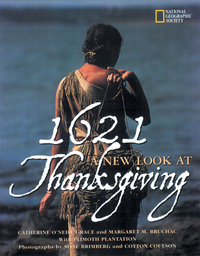Take a photo of a barcode or cover
This book was assigned for the history portion of our curriculum. I appreciated the short sections, vibrant photos and the conversations the book initiated for me & my 10 yr old. The truth about the fall feast that has been misrepresented for so many years is good to know.
A photo-essay from National Geographic and the Plimoth Plantation museum that looks at primary sources and Wampanoag perspective to dispel the persistent myth of "The First Thanksgiving."
“Unquestioning acceptance of biased interpretations can affect the way we treat one another, even today.”
“Unquestioning acceptance of biased interpretations can affect the way we treat one another, even today.”
informative
reflective
medium-paced
I'm very glad to see more books like this come out that debunk the ridiculous myth of Thanksgiving and the Pilgrims. The history I was taught was so wrong. It's far past time to correct it.
History frequently gets muddled up with myths and stereotypes, resulting in an imperfect understanding of our past. In this lengthy picture book for older children, the very first point made is that our myth of the U.S. Thanksgiving holiday is founded on one brief letter that sparked an entire Thanksgiving Legend. As an elementary student, I have vague memories of dressing up as Pilgrim with Black Hat and Buckle or as an Indian with paper bag vest and paper headband of feathers. I'm sure the lessons of sharing and goodwill and gratitude were all imparted with the best of intentions, but there's no doubt that those positive values had a backdrop of false history.
This book strives to peel back the layers of myth and describe what actually happened at the first Thanksgiving. Using photographs of reenactors and multiple sources that are referenced in the backmatter, Grace and Bruchac tell a no frills story of Thanksgiving that is frank in its discussion of the colonists' flaws and in the portrayal of the Native Wampanoag whose community had been decimated by illness.
Interesting and illuminating, this also piqued my interest about visiting Plimoth Plantation, which seems to have gone to considerable effort to tell a truer story through their living history program.
Includes two delicious looking recipes.
This book strives to peel back the layers of myth and describe what actually happened at the first Thanksgiving. Using photographs of reenactors and multiple sources that are referenced in the backmatter, Grace and Bruchac tell a no frills story of Thanksgiving that is frank in its discussion of the colonists' flaws and in the portrayal of the Native Wampanoag whose community had been decimated by illness.
Interesting and illuminating, this also piqued my interest about visiting Plimoth Plantation, which seems to have gone to considerable effort to tell a truer story through their living history program.
Includes two delicious looking recipes.
The origins of Thanksgiving through the lens of First Nations people with factual evidence.
This is essential reading for children who are learning about the American Thanksgiving holiday.
This is essential reading for children who are learning about the American Thanksgiving holiday.
I cannot say enough about this book - or how much I wish every teacher in the country would read it. With primary sources and a supposition of significant background knowledge of the colonial era, this is definitely a book for 5th grade and up. However, the chapters are short and can be adapted for 3rd and 4th graders, who are definitely old enough to understand what really happened in 1621.
What an amazing book! Not only does it dispel the myths surrounding the American tradition of Thanksgiving. But not only that, it also explains the nature of myths, where these myths came from, and comparing it to historical fact. Combine this with outstanding (educational) illustrations and photographs, and this book is invaluable.
The only problem I found was the descriptions that come with the photos on page 44-45. Why is it, that the white period actors are credited by name, but on the same page, Wampanoag Native participants do not receive the same acknowledgement?
The only problem I found was the descriptions that come with the photos on page 44-45. Why is it, that the white period actors are credited by name, but on the same page, Wampanoag Native participants do not receive the same acknowledgement?
informative
reflective
fast-paced
informative
reflective
medium-paced





